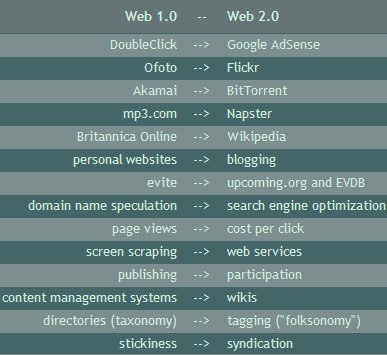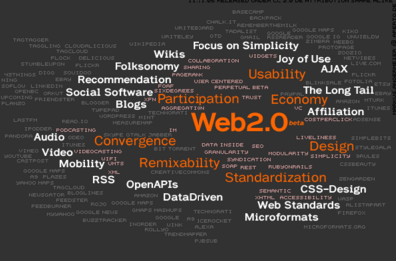
Web 2.0 : It's like your brain on LSD!
This article is an attempt to clarify just what we mean by Web 2.0
The term was coined by Dale Dougherty of O'Reilly Media during a conference brainstorming session with MediaLive International.
In the initial brainstorming, they formulated the sense of Web 2.0 by example:
 Web 2.0 can also be defined as : Websites with rich user interfaces that behave more like desktop applications than a collection of interlinked pages to be read.
Web 2.0 can also be defined as : Websites with rich user interfaces that behave more like desktop applications than a collection of interlinked pages to be read.In the strictest sense, the term refers to several separate technologies that make Web sites faster and easier to use. If you've used Google's Gmail service, Yahoo's Flickr photo sharing site or Microsoft's Windows Live, you've seen Web 2.0 in action.
Wikipedia defines it as “a second phase of development of the World Wide Web”. However, there isn’t a consensus on its exact meaning. Web 2.0 loosely includes weblogs, wikis, linklogs, podcasts, RSS feeds and other forms of many-to-many publishing; social software, web APIs, web standards, web services and Ajax.
 In Web 1.0, a small number of writers created Web pages for a large number of readers. As a result, people could get information by going directly to the source: Adobe.com for graphic design issues, Microsoft.com for Windows issues, and CNN.com for news. Over time, however, more and more people started writing content in addition to reading it. This had an interesting effect—suddenly there was too much information to keep up with! We did not have enough time for everyone who wanted our attention and visiting all sites with relevant content simply wasn’t possible. As personal publishing caught on and went mainstream, it became apparent that the Web 1.0 paradigm had to change.
In Web 1.0, a small number of writers created Web pages for a large number of readers. As a result, people could get information by going directly to the source: Adobe.com for graphic design issues, Microsoft.com for Windows issues, and CNN.com for news. Over time, however, more and more people started writing content in addition to reading it. This had an interesting effect—suddenly there was too much information to keep up with! We did not have enough time for everyone who wanted our attention and visiting all sites with relevant content simply wasn’t possible. As personal publishing caught on and went mainstream, it became apparent that the Web 1.0 paradigm had to change.Enter Web 2.0, a vision of the Web in which information is broken up into “microcontent” units that can be distributed over dozens of domains. The Web of documents has morphed into a Web of data. We are no longer just looking to the same old sources for information. Now we’re looking to a new set of tools to aggregate and remix microcontent in new and useful ways.
A big part of Web 2.0 is turning passive visitors and readers into active participants in producing the value that is offered by a website. If you’ve ever been addicted to a Web-based forum, then you know how powerful this can be. Web 2.0 is about taking that “power of community” and applying it to the Web as a whole.
The technology infrastructure of Web 2.0 is complex and evolving, but includes server software, content syndication, messaging protocols, standards-based browsers, and various client applications.
So if this is Web 2.0, what was its earlier avatar – Web 1.0?
The earlier avatar, that is Web 1.0, would be clearly demarcated content which was fairly static. You could not interact with it, add your comments or leave your mark. You used the software or the content as is and could not collaborate with other users of the same content.
By way of contrast. Back when it was happening, it was just ‘the web’ or the ‘dotcom era’.
Ashok Hingorani, CEO, Computact, (and an avid developer) takes it in his stride:
“Every product goes through the notorious Version 1 – the Net, Windows, etc. And they are always incomplete, buggy, with gaps. Above all, they designed with today’s technology in mind, and evolved rather than reengineered every few years. The Net is more than 15 years old. Its architecture does not take care of many things learned from hindsight, nor does it hande security/ privacy at all. You have to buy special software to do that.”
A website could be said to be built using Web 2.0 technologies if it featured a number of the following techniques:
- CSS, semantically valid XHTML markup, and Microformats
- Unobtrusive Rich Application techniques (such as Ajax)
- XUL (XML User interface Language)
- SVG (Scalable Vector Graphics)
- Syndication of data in RSS/Atom
- Aggregation of RSS/Atom data
- Clean and meaningful URLs
- Support posting to a weblog
- REST or XML Webservice APIs
- Some social networking aspects
- Javascript-based WinLIKE
- Java Web Start
- Flex/Laszlo/Flash
Let's summarize what we believe to be the core competencies of Web 2.0 companies:
- Services, not packaged software, with cost-effective scalability
- Control over unique, hard-to-recreate data sources that get richer as more people use them
- Trusting users as co-developers
- Harnessing collective intelligence
- Leveraging the long tail through customer self-service
- Software above the level of a single device
- Lightweight user interfaces, development models, AND business models
Web 2.0 is designed to be:
- Some Rights Reserved
- Cooperate, Don't Control
- Software delivered as a service thru the Web
Web 2.0 is after all not a product or object, not something we climb into or touch, but a concept that describes certain aspirations or internet tendencies.
Services such as Gmail, Google Maps, Flickr, del.icio.us, and the like may be expected to bear a "Beta" logo for years at a time.
Web 2.0 is white hot at the moment, and not just because of the hype, but because of the insane amount of stuff that's being built for it right now.
-----------------------------------
If u stuck with any term on this post, search for it using Google
More in-depth posts far beyond Web 2.0 are being prepared right now...
Useful Links:
- Oreilly - What's Web 2.0?
- Wikipedia.org Web_2.0 Definition
- Web 2.0 Workgroup
- Web 2.0 Conference
<.adjuster />
Your blog keeps getting better and better! Your older articles are not as good as newer ones you have a lot more creativity and originality now. Keep it up!
ReplyDeleteAnd according to this article, I totally agree with your opinion, but only this time! :)
You have really great taste on catch article titles, even when you are not interested in this topic you push to read it
ReplyDeleteGood post and this post helped me alot in my college assignement. Thank you for your information.
ReplyDelete